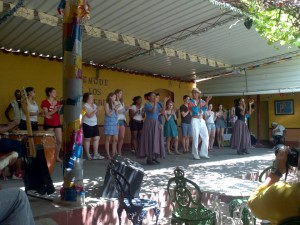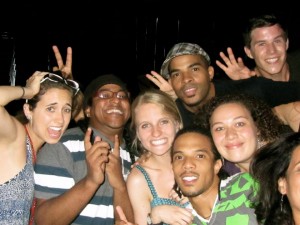Then and Now
May 3, 2012 by admin
The most interesting part about being in Cuba, by and large, was that after writing a thesis about tourism and Cuba in the 1990s, it was incredibly interesting to see how much research applied to the current situation in Cuba. Two certain themes come to mind when thinking of how my research applies to Cuba today: the “brain drain” of professionals leaving for tourist jobs with hard currency, and racism. Not only were both of these conditions evident, but also on several occasions I encountered firsthand the effects that tourism had on the social lives of Cubans. 
Essentially, the introduction of tourism in the 1990s and establishment of a dual economy later created a system that privileged those who had access to hard currency. In the 1990s and the beginning of the Special Period, hard currency in the form of Euros or dollars were heavily sought after because the Cuban peso had become nearly worthless (1USD ≈ 150pesos). The establishment of an official dual currency system didn’t do much to alleviate this problem either, as 1CUC≈24pesos. For this reason, many professionals found that, in the face of cuts on subsidies for medical supplies, food, and other government services, access to hard currency became a necessity to maintain living the way they could before. And the one industry with a direct line to large amounts of hard currency? Tourism.
So professionals began to leave their specialized jobs for less skilled work that had the promise of obtaining hard currency in the 1990s, and this happens frequently today. For example, one of the first days that we were in La Habana, a few of us took a walk along the Malecón to do some exploring. While walking along, we ran into a security guard who we ended up talking to for a little bit, and he explained to us that he had left his professional job as an English teacher about a year ago and was working as a security guard while he took classes to become a tour guide. He had done this because he couldn’t afford to pay for his whole family on the salary he received as a teacher. The most interesting part of the conversation was the way he phrased his explanation on leaving his professional job. It wasn’t that he was unhappy with his teaching job, but he specifically said he left for the “opportunity” to work in the tourist industry; it wasn’t guaranteed that he would be given a job but even the opportunity was enough to move him away from his professional job.
The other pervasive effect of tourism on social life was the reintroduction of racism into the everyday lives of Cubans. Years earlier, the revolutionary government had proclaimed the end of racism in Cuba. Racism comes from the idea that one class benefits from the marginalization of another class, but in a “classless” society such as Cuba, they argued, nobody benefitted from that racism. In its defense, the revolutionary government did a remarkable job mitigating the effects of racism prior to the reintroduction of tourism. However, tourism made evident racism once again, and many dark skinned Cubans weren’t, and still aren’t, allowed into tourist hotels for fear of alarming the guests. The glaring example of our trip in Cuba was our arranged meeting with a hip-hop group, Los Hermanazos. They arrived and the hotel simply just would not let them enter the building, despite the fact that the head of our group went down and explained that we had a purely academic meeting arranged. The hotel wouldn’t let them in because they were dark skinned Cubans; this was a problem that resurrected in the 1990s and certainly carried over into today. Fortunately, the hotel relented and allowed us to meet with them.
Writing about tourism in the 1990s had given me some insight as to what to possibly expect today. The circumstances are certainly different, but even though the economy is much better off today than it was in 1990, these social problems brought about by tourism still exist, very much so, in Cuba. However, it was certainly very interesting to see a real life manifestation of previous research and work.
3 Responses to “Then and Now”
Leave a Reply
You must be logged in to post a comment.



veterinary seo
» Then and Now CUBAN TRANSITIONS
stem cell therapy
» Then and Now CUBAN TRANSITIONS
regenerative therapy
» Then and Now CUBAN TRANSITIONS